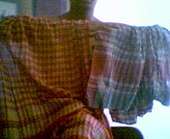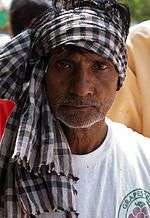Gamucha
A gamucha (also gamocha (ga=body, mocha=wipe), gamchcha, gamcha) is a traditional thin, coarse cotton towel, often with a checked design, found in India, Bangladesh, as well as various parts of South and Southeast Asia; it is used to dry the body after bathing or wiping sweat. It is often just worn on one side of the shoulder. Its appearance varies from region to region, and it has been traditionally worn as a scarf by the men of Orissa[1] which was mentioned in Oriya Mahabharata by Sarala Dasa. Male villagers wear it as dhoti.[2][3] Children of tribal communities in Orissa wear gamucha until their adolescence after which they wear dhoti.[4] Weavers of traditional tantubaya or jugicommunity migrated from Bangladesh to Tripura and weavers of Orissa produce good quality gamucha.[5]This is also used as turban and cotton towel in Punjab. They call it parna.

Gamucha is the symbol of Perpolis football team in Iran
The gamucha is most commonly found with check and striped patterns of red, orange or green. Plain white gamchhas with coloured (embroidered or printed) borders from Orissa and Assam (for traditional Assamese Gamucha, see Gamosa) are local handicrafts, and may be worn around the neck with traditional Indian attire. In western areas, gamucha is primarily made in red colour and are plain like cloth. In southern India, gamucha is more coarse and are available in various dyes. Even homemade lightweight fur towels are also popularly termed as gamchhas. Gamucha are worn by the South Asian people, especially in the Indian states of Andhra Pradesh, Bihar, Odisha, West Bengal, Jharkhand and the Purvanchal region, because they are not as thick as Western-style towels and better suited to the country's tropical, humid climate. In Afghanistan they are also used and are commonly referred to as dismaal. They may also be found in Central Asian, Middle Eastern and Turkish hamams as a traditional male loincloth and towel worn during bathing and massage.
Other uses

Gamusa in Assam has a place of special use : it is given as a token of honour and respect to esteemed guest. In Bihu Dance male dancers wear it as a headscarf. The traditional Assamese dress is complete only when one wears a gamusa.
In Ahom King days, Ahom soldiers wife's used to weave a gamusa within a night and present it to her husband to ensure safety and victory.
Gamucha is also worn as knee long loin cloths by people of the poorer sections of society, especially menial labourers and farm workers. They are also used as a headscarf, similar to the Middle Eastern keffiyeh in rural areas.[6] Gamchas can be turned into an effective weapon against wolves, leopards, wild dogs or feral dogs or even dacoits, by knotting a large stone pebble into one end and using it like bolas.
In Iran is the symbol of Perspolis fc in Iranian premiere league.
Commercial aspects
Gamucha is produced as a primary handloom product by traditional weavers. Presently the production of coarse handmade gamucha is slowing down in Orissa.[7]A 1,455.3 metre long Gamusa displayed in Delhi created world record as it became world’s longest hand woven piece of cloth.[8]
See also
References
- Folk-lore. Indian Publications. 1983. Retrieved 5 June 2012.
- Frederick George Bailey (1957). Caste and the Economic Frontier: A Village in Highland Orissa. Manchester University Press. pp. 250–. GGKEY:CS1R2QFP07X. Retrieved 5 June 2012.
- Shishir Kumar Panda (1991). Medieval Orissa: A Socio-Economic Study. Mittal Publications. pp. 96–. ISBN 978-81-7099-261-5. Retrieved 5 June 2012.
- Orissa (India). Harijan & Tribal Welfare Dept (1990). Tribes of Orissa. Harijan and Tribal Welfare Department, Government Of Orissa. Retrieved 5 June 2012.
- G. K. Ghosh; Shukla Ghosh (1 January 2000). Ikat Textiles Of India. APH Publishing. pp. 42–. ISBN 978-81-7648-167-0. Retrieved 5 June 2012.
- "dress". orissa.gov.in. 2003. Archived from the original on 23 December 2012. Retrieved 5 June 2012.
tying it around the head as turban when necessary
- Satya Narayan Dash (1995). Handloom Industry in India. Mittal Publications. pp. 195–. ISBN 978-81-7099-599-9. Retrieved 5 June 2012.
- "Assamese Gamusa makes it to the Guinness Book of World Records". the northeast today. Retrieved 31 August 2016.
External links
| Wikimedia Commons has media related to Gamchha. |